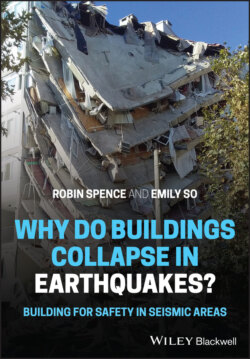Читать книгу Why do buildings collapse in earthquakes? Building for safety in seismic areas - Robin Spence - Страница 25
2.2.9 The 11.3.2011 Great Tohoku Japan Earthquake: Mw9.1, Over 18000 Deaths and Missing
ОглавлениеLess than three weeks after the Christchurch earthquake, a huge Mw 9.1 earthquake occurred at 14.46 local time in the Japan trench off the coast of Tohoku in north‐east Japan. The event had the largest magnitude recorded in Japan since the beginning of instrumental seismology around 1900. Intense and damaging ground motion, lasting as much as four minutes, was felt over most of northern Japan, and the earthquake triggered a tsunami, which was damaging over about 650 km of the coastline of four regions (Sanriku, Miyagi, Joban and Kanto). The tsunami toppled sea defences, inundated more than 500 km2 of land and destroyed many settlements and towns along the coastline. The effects of the tsunami also led to the failure and release of radioactive material from two reactors of the Fukushima Daiichi nuclear power station, requiring a massive and prolonged evacuation of hundreds of thousands of residents from within 20 km of the site.
Direct losses from the event are thought to be in excess of $215bn, making this the world's costliest disaster, and indirect losses from the nuclear reactor failure continue to rise. The total casualties resulting from the event have been estimated over 18000. The vast majority (>90%) of these were deaths by drowning, directly caused by the tsunami, but significant numbers of casualties (>4%) were crush injuries caused by the collapse of buildings over a wider area. As in Christchurch, the scale of the damage was largely because the buildings and the sea defences were not built to withstand the effects of an earthquake of that magnitude. At that time, the maximum magnitude envisaged in the Japan trench, on which building and coastal defence design was based, was Mw8.4.
The damage caused by the earthquake and tsunami was studied by several reconnaissance teams. The summary of damage to buildings presented here is largely based on reporting by the UK's EEFIT team (EEFIT 2011b). The building stock in the 20 towns and cities affected by ground shaking (but not the tsunami) which were visited by the EEFIT team consisted of an estimated 81% timber‐framed structures, 14% RC structures and 4% steel framed structures. In surveys conducted by EEFIT in the areas where the ground shaking was seriously damaging, as many as 25% of all buildings were recorded as unsafe and another 30% as damaged (EEFIT 2011b). Each of the three major building types was equally affected, though damage to RC buildings was concentrated on those built before improved earthquake‐resistant design regulations were introduced in 1981.
Figure 2.15 Typical damage in tsunami‐affected region. Timber frame building in Kamaishi City at a location with a maximum of 7 m inundation.
Source: EEFIT. Reproduced with permission.
Figure 2.16 Typical damage in tsunami‐affected region. Steel frame building in Yamamoto‐cho, Miyagi Province which was struck by a tree trunk in the debris flow.
Source: EEFIT. Reproduced with permission.
In the coastal areas affected by tsunami inundation, damage was immense, but extremely variable, depending on inundation depth, flow velocity, debris entrainment in the flow and sheltering. Inundation depths varied up to a maximum of 16 m at Onagawa town, where most buildings were destroyed, and 12% of the population living in the inundated zone were killed. The structural frames of RC and steel frame buildings generally survived, except where impacted by heavy debris, but damage to cladding and non‐structural elements was extensive (Figures 2.15 and 2.16). Timber‐framed buildings were, however, frequently destroyed and sometimes swept from their foundations by the force of the tsunami at inundation depths of 3–4 m or more.
Overall, data collected by the National Police Agency (NPA) in November 2011 (NPA 2011) showed that 120 157 buildings were totally destroyed and a further 830 000 buildings had been damaged.
